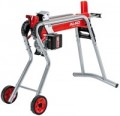Splitting force
The greatest force that the wood splitter is able to apply to the workpiece in the process of splitting.
This parameter is relevant for hydraulic and rack units (see "Type"). Even in the simplest such devices, the splitting force reaches several tons. In general, high force allows you to cope with hard and thick workpieces, however, it requires high power and strength, which significantly affects the price and weight of the entire unit. Therefore, it is worth choosing a model according to this characteristic, taking into account the specifics of the work.
So, for use in the private sector, a wood splitter with a splitting force of up
to 5 tons is considered quite sufficient, for boiler rooms and other relatively large consumers —
5-8 tons (up to 10 tons), and
more powerful devices are intended mainly for industrial use.
Oil volume (hydraulic system)
The total amount of oil that can fit into the hydraulic system of the respective log splitter (see "Type"). This parameter allows you to estimate how much oil is required for one refueling or refilling of the unit.
Protective box
Models that are equipped with a
protective box that prevents the log from falling apart and the logs falling down after it is split. It is designed to stop chips and logs that can scatter in all directions under the pressure of the knife. Often, a protective box is created from perforated sheet metal. Thanks to the perforation, the wood splitter operator can visually control what is happening in the working area. Most often, the protective box is installed on wood splitters with a horizontal log arrangement. In such models, when chopping firewood, the wood can literally “shoot” forward, which can be dangerous. And in vertical wood splitters, wood chips always just fly down, which in itself is absolutely safe.
Stand
The presence of high legs
(stands) for a horizontal wood splitter will allow you to use it when it is installed immediately on the ground, floor. There is no need to make an additional elevation in the form of a table, a workbench for more convenient feeding and chopping of small logs. But compact models of
horizontal wood splitters without a stand are of two types. The first includes ground models for chopping powerful logs, which it makes no sense to raise to a height. The second type provides wood splitters for installation on a hill, which, due to the lack of a stand, must be provided in advance. In both cases, the absence of a stand (high legs) makes the model more compact and more mobile.

